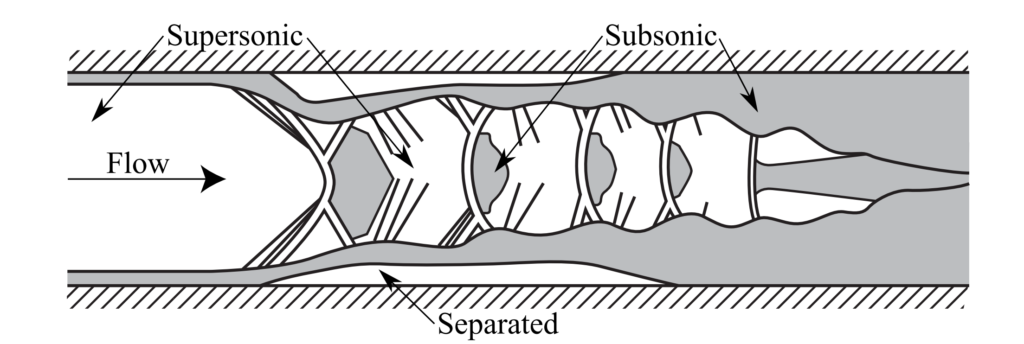The dual-mode scramjet is a type of hypersonic air-breathing engine that operates as a conventional ramjet at lower Mach numbers (3 ∼ 5) with mostly subsonic flow in the combustor and as a scramjet at higher Mach numbers (M ≥ 5) with mostly supersonic flow in the combustor. A key challenge on the critical path to deploying a reliable dual-mode scramjet engine is engine unstart. During unstart, the pseudo-shock, a complex compressive flow structure responsible for increasing the static pressure and slowing of the incoming flow for efficient combustion is pushed out of the vehicle. Restarting of a hypersonic vehicle during flight is a highly complicated and not well understood process which historically has led to loss of vehicles (Boeing X-51 Waverider).
The pseudo-shock is typically divided into two streamwise regions. Upstream is the shock train, a mostly supersonic region dominated by a series of compression waves, mostly shocks, embedded in a viscous wall flow. Different types of shock trains are typically encountered in the pseudoshock system most commonly the normal and oblique shock trains. A normal shock train generally has a leading bifurcated normal shock followed by several nonbifurcated shocks. The bifurcated normal shock train and the ramjet operating mode is of particular interest because it is the most inherently unsteady and must be successfully transited before reaching scramjet mode. Downstream of the shock train, if the isolator is long enough, additional shock-less compression occurs in the mixing region where thick turbulent boundary layers control the mixed sub/supersonic flow.
The pseudoshock is housed in a short duct called the isolator which is a critical structure that separates the inlet from the combustor. At the Gas Dynamics Imaging Laboratory, we study Shock-Boundary Layer Interactions (SBLI), unstart and other compressible flow phenomena in our University of Michigan Direct Connect Isolator facility (UMDCI).
Publications
Edelman, Louis M., et al. “Three-Dimensional Structure and Modeling of a Normal Bifurcated Shock Train from Experimental Measurements.” AIAA SCITECH 2022 Forum. 2022.
Edelman, Louis M., et al. “Application of Flux-Conserved Modeling to an Unsteady Combustion Driven Pseudo-Shock.” AIAA Scitech 2021 Forum. 2021. (Best Paper Award)
Edelman, Louis M., and Mirko Gamba. “Structure of a Mach 2 shock train from experimental measurements.” AIAA Scitech 2020 Forum. 2020.
Edelman, Louis M., and Mirko Gamba. “Time Delay Response of a Mach 2 Pseudo-Shock to Downstream Forcing.” AIAA Scitech 2019 Forum. 2019.
Hunt, Robin L., and Mirko Gamba. “On the origin and propagation of perturbations that cause shock train inherent unsteadiness.” Journal of Fluid Mechanics 861 (2019): 815-859.
Hunt, Robin, Louis M. Edelman, and Mirko Gamba. “Scaling of pseudoshock length and pressure rise.” 2018 AIAA Aerospace Sciences Meeting. 2018.
Hunt, Robin L., and Mirko Gamba. “Shock train unsteadiness characteristics, oblique-to-normal transition, and three-dimensional leading shock structure.” AIAA journal 56.4 (2018): 1569-1587.
Hunt, Robin, James F. Driscoll, and Mirko Gamba. “Periodic forcing of a shock train in Mach 2.0 flow.” 55th AIAA aerospace sciences meeting. 2017.



